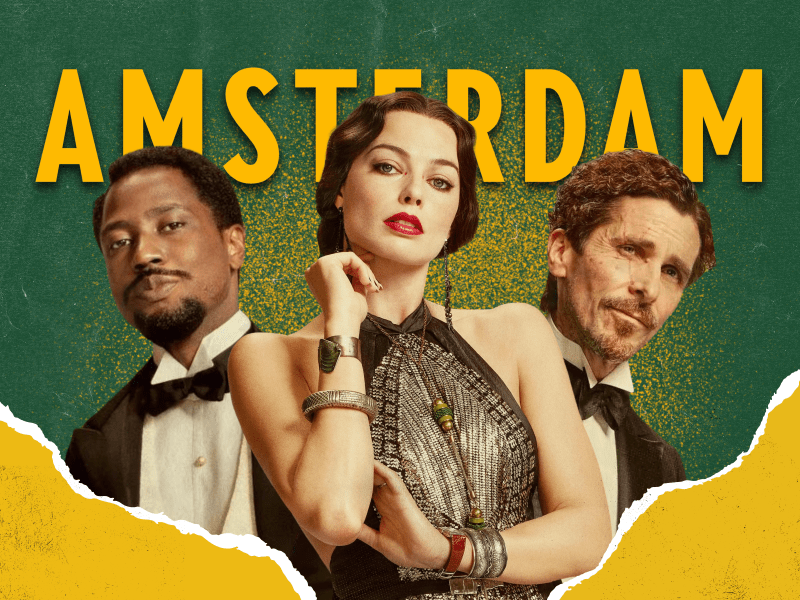I knew that I was going to see “Amsterdam” on opening weekend the moment I saw its cast listed in the TV trailer: Christian Bale, Margot Robbie, John David Washington, Anya Taylor-Joy, Robert De Niro, Mike Meyers, Rami Malek, Chris Rock, Zoe Saldaña and … Taylor Swift? And to top it off, the film is made by David O. Russell, director of one of my favorite films, “The Fighter.” How could a combination like this one ever miss?
I was forced to slightly temper my expectations for the film when I realized that “Amsterdam” received a disappointing 33% from critics on Rotten Tomatoes. I responded internally with defiance. I would rather be excited about something and be let down than never be excited by anything at all. I entered the theater with an open mind to the best of my abilities, with only a vague thought lingering from a review I caught — in the excerpts collected on Rotten Tomatoes — stating that the film tries and fails to emulate the tone and style of Wes Anderson.
“Amsterdam” starts fast. Right away, we find out that Christian Bale plays a doctor in 1930s New York named Burt Berendsen, who treats veterans of the First World War. Burt, too, is one of these wounded veterans, having lost an eye in France. In the midst of a chaotic day, Burt’s secretary tells him that he is to meet his work partner Harold Woodman (John David Washington) about a potential operation for which they have been hired. The operation turns out to be an autopsy for their former commander General Meeckins, whose daughter Liz (Taylor Swift) suspects foul play in his death. With the help of friend Irma St. Clair (Zoe Saldaña), Burt determines that the general was indeed poisoned, but when he and Harold return to report the discovery to Liz, she nervously tries to avoid them before being pushed under a moving car by a mysterious passerby. The mystery man then cleverly accuses Burt and Harold of the murder before the shocked and confused crowd, and the two flee the scene as the prime suspects in the case.
The opening sequence, which includes a flashback to World War I in France and then post-war in Amsterdam, is arguably the best part of the film. Beautiful camera work and genuinely funny performances by Chris Rock and Mike Meyers elevate a story that delves into strong themes such as the power of art to transfigure grotesque disfigurement, racism in America and what it means to love and be loved. In Amsterdam, where three friends, Burt, Harold and Valerie (Margot Robbie) dance and celebrate art, life is beautiful and joyous. The film is at its best when it is beautiful and joyous, too. It is back in New York where things begin to fall apart.
To start, the plot is convoluted to a fault. There are, literally, punches thrown without explanation. At the center of the problem is the role of Tom Vose (Rami Malek), who either acts repeatedly without motivation or is playing 6D chess on a level that after a second and now a third viewing, I still cannot keep up with. On the other end of the spectrum, expositional dialogue frequently sucks the air out of tension in scenes, as the film desperately tries to establish what has happened and what will happen in place of genuine conflict and story.
In one example, Harold re-encounters his lost love Valerie in a scene that recalls “Casablanca.” “Of all the gin joints in all the towns in all the world, she walks into mine!” laments Rick Blaine (Humprhrey Bogart), in a moment that establishes the emotional stakes for the entire film. In contrast to “Casablanca,” where the reason for Ilsa Lund’s (Ingrid Bergman) initial disappearance is not revealed until late in the film, in “Amsterdam” when Harold and Valerie cross paths again, it lacks the same weight because what’s played as a surprise was never really a mystery. Valerie told Harold exactly why she couldn’t leave Amsterdam with him before, even if she left some details out.
In general, it felt like performances suffered because, in addition to the expositional dialogue and problems with the story, the actors and the director failed to find a unifying tone. At some points, actors play a quirky sensibility in a brilliant manner — such as when Burt, Harold and Valerie sing a song and then Valerie parades her art. At other points, it seems like actors don’t make a choice between enacting a realist drama or quirky comedy out of genuine confusion of what’s expected of them. The scene where the investigators first interrogate Burt and Harold comes to mind. There is also the problem of an overuse of voice-over narration, which sometimes talks over what could have been some of the best jokes or moments of surprise and confusion if the scenes were simply played visually. Perhaps a more unified tone could have saved the film from its other deficiencies, as audiences will forgive some things that don’t work if the collective piece feels whole.
Leaving the theater the first time, as I thought long and hard about what did and didn’t work with the film, I was reminded of a comment from Quentin Tarantino, who said of Brian De Palma’s “Bonfire of the Vanities” that it was “the kind of mess that only a great filmmaker makes.” “Amsterdam” hits great highs but is undone by the lack of a unifying vision. It ultimately tries to do too much, but I appreciated every minute of the attempt. I would much rather watch a filmmaker swing for the fences and strike out than bunt.
Editor’s Note: This article is a review and contains subjective opinions, thoughts and critiques.
